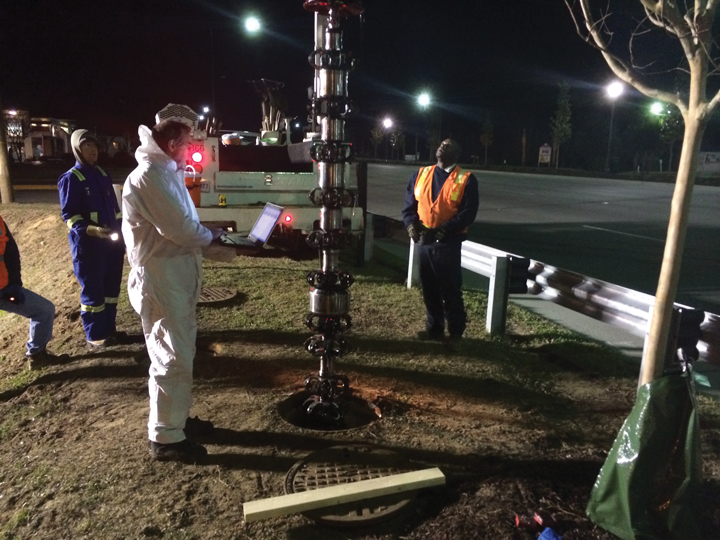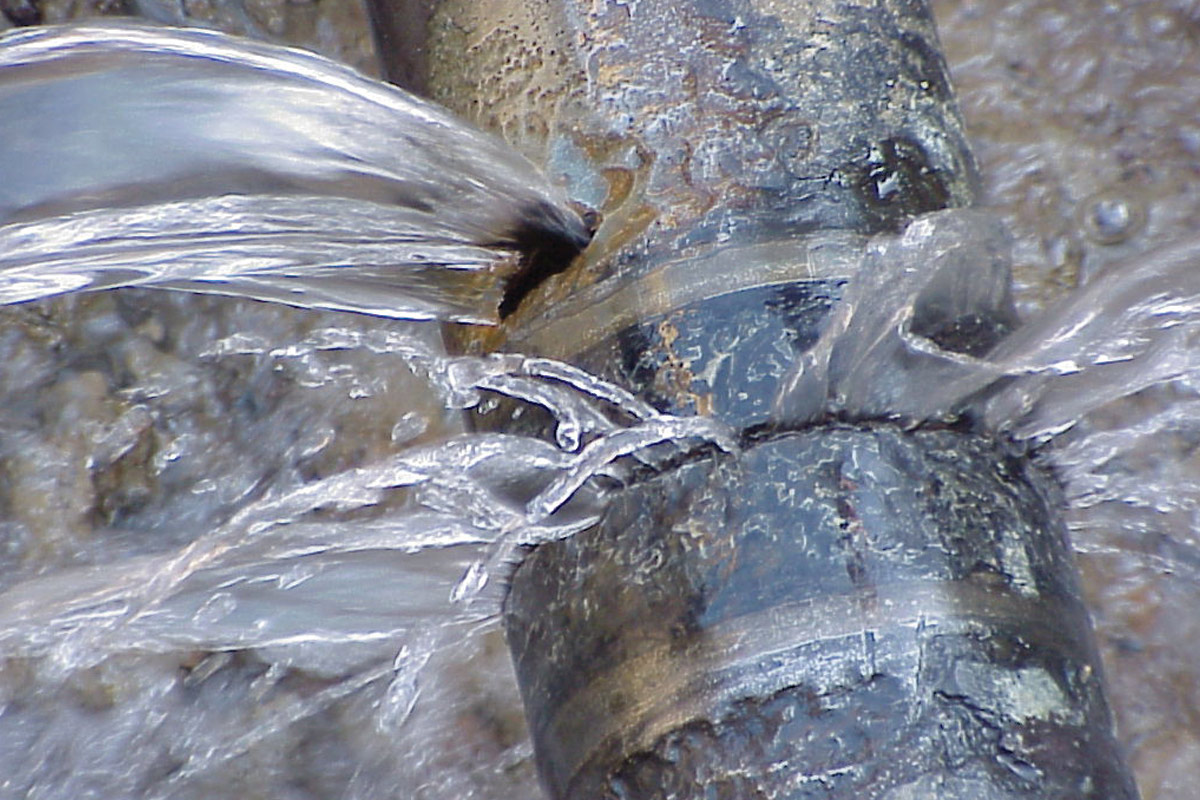Detecting Corrosion
June 13, 2014
 Mount Pleasant Waterworks (MPW), the water and wastewater service provider Mount Pleasant, S.C., was presented with a complicated problem: underground force mains in unknown conditions.
Mount Pleasant Waterworks (MPW), the water and wastewater service provider Mount Pleasant, S.C., was presented with a complicated problem: underground force mains in unknown conditions.At one extreme of the solution spectrum, the utility could continue to react to main breaks and fix them as them occur. At the other extreme, the utility could replace everything all at once. These different choices were united by a common thread: They were both too expensive. By replacing its pipes too late, the economic cost was significant and the social and ecological costs were humungous. By replacing its pipes too soon, the social and ecological costs were reduced, but the economic costs were unrealistic. MPW sought to find a better way.
“Mount Pleasant Waterworks, like many wastewater utilities expanded their transmission systems in the 1980s with large diameter ductile iron pipe. These pipes are now experiencing pipe failures, in some cases prematurely. MPW has been working on a comprehensive asset management program for several years now. Condition assessment tools are a major component of our program that helps us predict our renewal and replacement schedules. These new smart tools are paying big dividends in making smarter decisions on how and where we spend our R&R dollars now and in the future,” said Mount Pleasant Waterworks general manager Clay Duffie.
 Engineers at MPW sought the assistance of Brown & Caldwell to bring technology providers to Mount Pleasant and institute a more proactive asset management plan. Technologies considered were CCTV, laboratory analysis, external ultrasonic testing, external broadband electromagnetic testing and in-line remote field testing. While MPW had had some experience with the first four methodologies, in-line remote field testing was a new approach for the utility. These tools travel through the pipeline, employing an electromagnetic technology that allows them to measure metallic pipe wall thickness with an exciter-detector setup. The tool’s exciter emits an alternating current, while the tool’s detector measures changes in the signal as it travels through the pipe wall.
Engineers at MPW sought the assistance of Brown & Caldwell to bring technology providers to Mount Pleasant and institute a more proactive asset management plan. Technologies considered were CCTV, laboratory analysis, external ultrasonic testing, external broadband electromagnetic testing and in-line remote field testing. While MPW had had some experience with the first four methodologies, in-line remote field testing was a new approach for the utility. These tools travel through the pipeline, employing an electromagnetic technology that allows them to measure metallic pipe wall thickness with an exciter-detector setup. The tool’s exciter emits an alternating current, while the tool’s detector measures changes in the signal as it travels through the pipe wall.To test this new approach, the utility hired PICA Corp. to tackle a 16-in. force main that had experienced a few failures in the previous five years.
The Project
The Simmons Road force main consisted of 4,200 ft of cement lined, ductile iron pipe, starting near a local pump station and ending a few thousand feet short of a treatment plant. Ultimately, MPW, Brown & Caldwell and PICA decided to divide the pipeline into two sections and inspect each by using winches to pull PICA’s 16-in. SeeSnake tool through the line. The fieldwork took place in spring 2012 and the results were a bit surprising to everyone.
Initial expectations were for the line to be in good shape near the start of the inspection because this area consisted of pipe at lower elevations. If any corrosion was anticipated, it was expected as the line moved farther downstream with some sections of gravity pipe and the possibility for local high points and air pockets to allow internal CO2 corrosion. In fact, the PICA data showed a pipeline with significant wall loss in the initial 550 ft, followed by pipe that was in near pristine condition. The surprising nature of these results prompted MPW and Brown & Caldwell to perform excavations and verify the accuracy of the data before acting upon it.
Corrosive Section
Pipe number 006 was selected for verification because of its ease of excavation and the reported presence of a through-hole, along with a 13 percent remaining wall indication within the joint. When the pipe piece was removed, there was no immediate visual indication of any through-holes; however, after the piece was pressure washed and dirt removed from the external wall, two large indications revealed themselves immediately. With the confidence of having accurate data, MPW took immediate action to prevent the chance of a large failure in the compromised sections of pipe.
Before simply replacing the pipe, Brown & Caldwell and MPW met to assess why this section of pipe was experiencing surprising levels of corrosion. The teams concluded that the location of the corroded pipe was near a local marshland and estuary that experiences changing tidal levels. As the pipeline traveled downstream, it moved farther and farther away from these marshlands and it’s hypothesized that the external conditions become friendlier. Rehabilitation was planned with this in mind, and MPW decided to relocate the corroded portions of the pipeline by rerouting it away from the waxing and waning of the waters. Based on the SeeSnake data, MPW was able to forgo the replacement of any of the downstream 3,700 ft of pipe that recorded little corrosion. MPW estimates savings of $2 million based on deferred pipe replacement and proactive condition assessment.
“So far, in the two condition assessment projects that we have used the SeeSnake, we have spent less than 5 percent of the pipe replacement cost using this technology. In return, we have saved at least 65 percent of the pipe replacement cost by only replacing and rehabilitating those sections of the pipe that really needed it,” said Mount Pleasant Waterworks engineering manager David Niesse.
 Condition Assessment Plan
Condition Assessment Plan
After assessing each of the inspection technologies, MPW reevaluated its Condition Assessment Plan of the remaining force mains in town. Based on the Risk Ranking that Brown & Caldwell helped establish, a 14,000-ft section of 12-in. force main along a local highway was selected for the next round of inspections. Brown & Caldwell again helped organize access to the pipeline and project logistics. Crews were mobilized in February 2014.
Unlike the inspection from 2012 when winches were used, the length of this pipeline prompted MPW to use a free-swimming SeeSnake. Prior to inspecting the line, a light cleaning was performed along with a caliper of the internal diameter of the pipeline. This was done to ensure that no obstructions would prevent the tool from reaching its retrieval location, which was a downstream junction structure. With a free-swimming approach, the inspection tool (and the cleaning/caliper tools) is launched into the line under pressure and propelled via the native flow in the force main.
The Remote Field Testing tool delivers optimum results when traveling at approximately 15ft/min. To accommodate this velocity, MPW was able to reroute local flow and shutdown certain pump stations in a timely manner to allow for an 18-hour inspection window. The local ingenuity allowed for a seamless SeeSnake inspection. The SeeSnake was launched into the force main at 8:18 a.m. and arrived at the junction structure at 2:08 p.m. The tool was removed through the manhole by a crane before being washed and the data downloaded for analysis.
A preliminary report has been completed for the free-swimming inspection and MPW is beginning to incorporate the new information into their larger Asset Management Plan. Similar to the previous year’s project, this pipeline also had sections that interacted with local marshlands and an initial look at the data indicates that corrosion is more active in these sections. Verification digs will be scheduled in the coming months, followed by appropriate rehabilitation and repairs.
In the last few years, MPW has increased its investment of time and money into an enhanced Condition Assessment Plan. While just now in the beginning stages, MPW is already starting to see a return on its investment while acting as a model utility employing today’s latest technologies.
Chris Garrett is general manager at PICA Corp.

 Condition Assessment Plan
Condition Assessment Plan


